Effect of Social Media on Consumer Behavior in Tourism: UWL Students
VerifiedAdded on 2022/08/12
|39
|9919
|149
Report
AI Summary
This report investigates the impact of social media on consumer behavior within the UK tourism industry, with a specific focus on students at the University of West London (UWL). The research explores the background of social media's influence, examining its role in shaping consumer perceptions and purchasing decisions. The study addresses research questions regarding the effect of social media tools (e.g., Facebook, Instagram, blogs) on the hospitality sector, the relationship between social media use and consumer behavior in tourism, and the structure of the UK tourism industry in relation to UWL student interests. The literature review covers the concepts of social media and consumer behavior, the effects of social media, and its importance. The methodology section outlines the research philosophy, approach (qualitative and quantitative), strategy, data collection, sampling, and ethical considerations. The report aims to analyze and evaluate the concepts, effects, and importance of social media on consumer behavior, ultimately providing recommendations for the tourism industry. The findings aim to provide insights into how social media platforms influence consumer choices, preferences, and overall behavior within the tourism sector, particularly among the target demographic of UWL students.
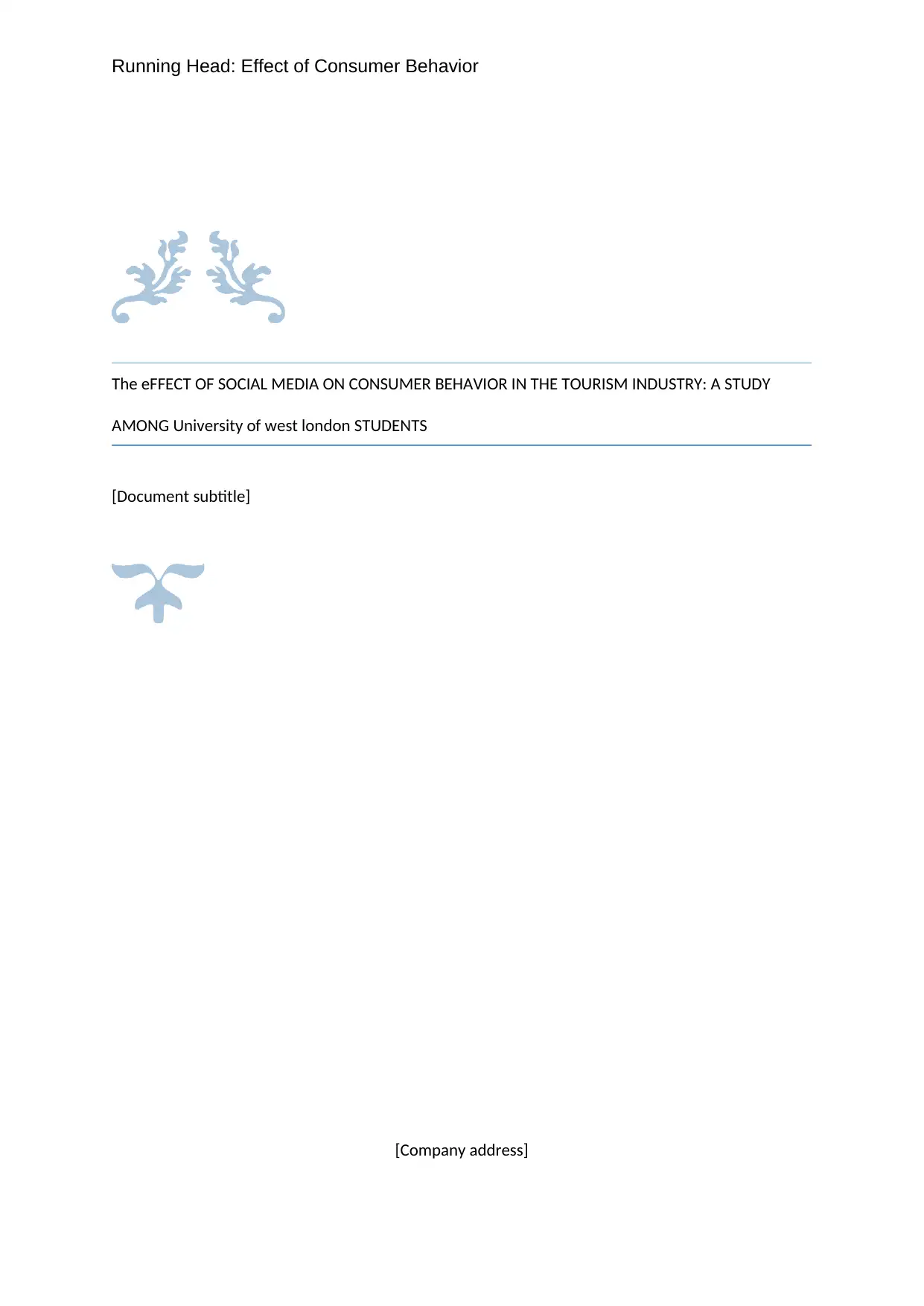
Running Head: Effect of Consumer Behavior
The eFFECT OF SOCIAL MEDIA ON CONSUMER BEHAVIOR IN THE TOURISM INDUSTRY: A STUDY
AMONG University of west london STUDENTS
[Document subtitle]
[Company address]
The eFFECT OF SOCIAL MEDIA ON CONSUMER BEHAVIOR IN THE TOURISM INDUSTRY: A STUDY
AMONG University of west london STUDENTS
[Document subtitle]
[Company address]
Paraphrase This Document
Need a fresh take? Get an instant paraphrase of this document with our AI Paraphraser
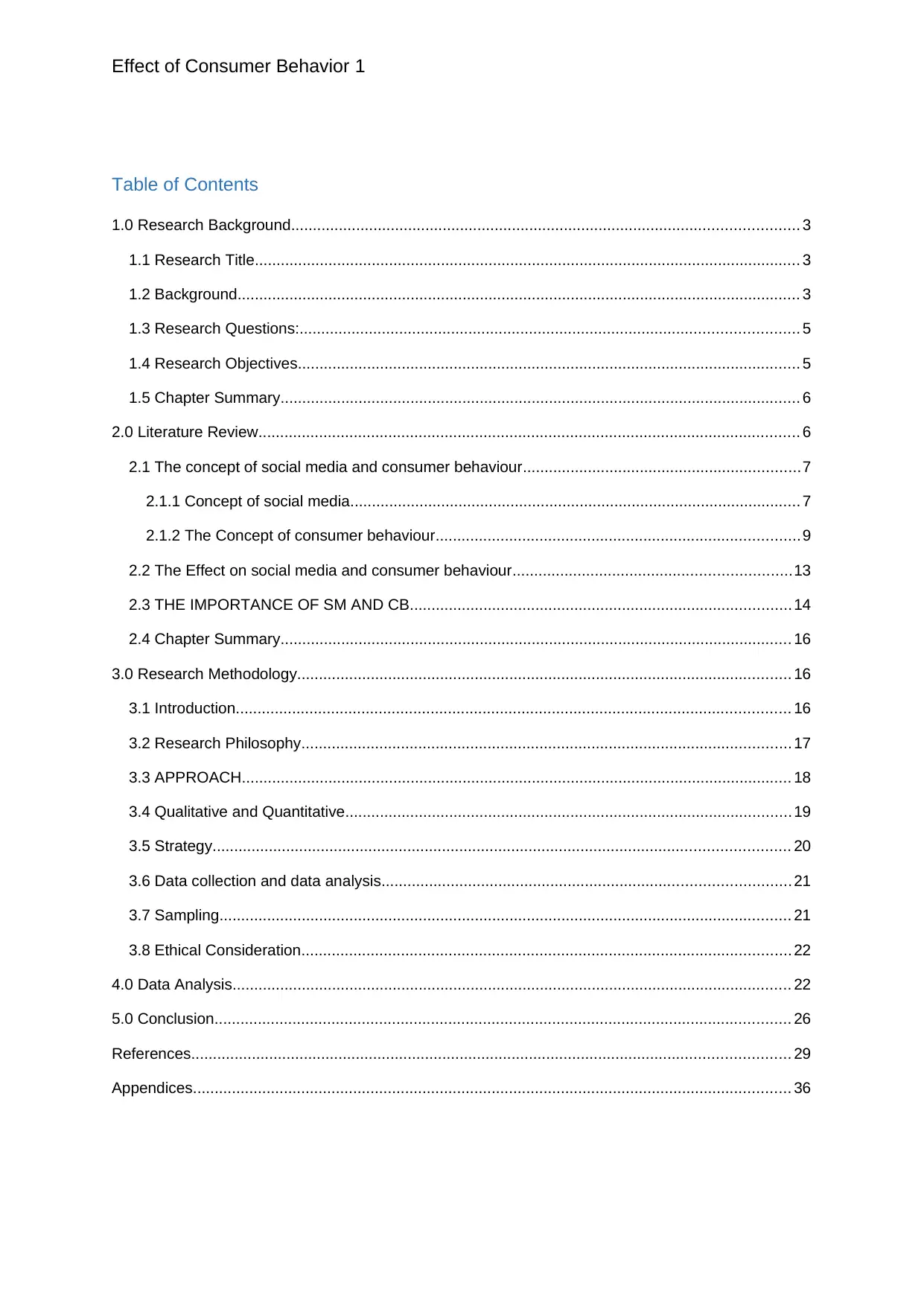
Effect of Consumer Behavior 1
Table of Contents
1.0 Research Background..................................................................................................................... 3
1.1 Research Title.............................................................................................................................. 3
1.2 Background.................................................................................................................................. 3
1.3 Research Questions:................................................................................................................... 5
1.4 Research Objectives.................................................................................................................... 5
1.5 Chapter Summary........................................................................................................................ 6
2.0 Literature Review............................................................................................................................. 6
2.1 The concept of social media and consumer behaviour................................................................7
2.1.1 Concept of social media........................................................................................................ 7
2.1.2 The Concept of consumer behaviour....................................................................................9
2.2 The Effect on social media and consumer behaviour................................................................13
2.3 THE IMPORTANCE OF SM AND CB........................................................................................14
2.4 Chapter Summary...................................................................................................................... 16
3.0 Research Methodology.................................................................................................................. 16
3.1 Introduction................................................................................................................................ 16
3.2 Research Philosophy................................................................................................................. 17
3.3 APPROACH............................................................................................................................... 18
3.4 Qualitative and Quantitative....................................................................................................... 19
3.5 Strategy..................................................................................................................................... 20
3.6 Data collection and data analysis.............................................................................................. 21
3.7 Sampling.................................................................................................................................... 21
3.8 Ethical Consideration................................................................................................................. 22
4.0 Data Analysis................................................................................................................................. 22
5.0 Conclusion..................................................................................................................................... 26
References.......................................................................................................................................... 29
Appendices.......................................................................................................................................... 36
Table of Contents
1.0 Research Background..................................................................................................................... 3
1.1 Research Title.............................................................................................................................. 3
1.2 Background.................................................................................................................................. 3
1.3 Research Questions:................................................................................................................... 5
1.4 Research Objectives.................................................................................................................... 5
1.5 Chapter Summary........................................................................................................................ 6
2.0 Literature Review............................................................................................................................. 6
2.1 The concept of social media and consumer behaviour................................................................7
2.1.1 Concept of social media........................................................................................................ 7
2.1.2 The Concept of consumer behaviour....................................................................................9
2.2 The Effect on social media and consumer behaviour................................................................13
2.3 THE IMPORTANCE OF SM AND CB........................................................................................14
2.4 Chapter Summary...................................................................................................................... 16
3.0 Research Methodology.................................................................................................................. 16
3.1 Introduction................................................................................................................................ 16
3.2 Research Philosophy................................................................................................................. 17
3.3 APPROACH............................................................................................................................... 18
3.4 Qualitative and Quantitative....................................................................................................... 19
3.5 Strategy..................................................................................................................................... 20
3.6 Data collection and data analysis.............................................................................................. 21
3.7 Sampling.................................................................................................................................... 21
3.8 Ethical Consideration................................................................................................................. 22
4.0 Data Analysis................................................................................................................................. 22
5.0 Conclusion..................................................................................................................................... 26
References.......................................................................................................................................... 29
Appendices.......................................................................................................................................... 36
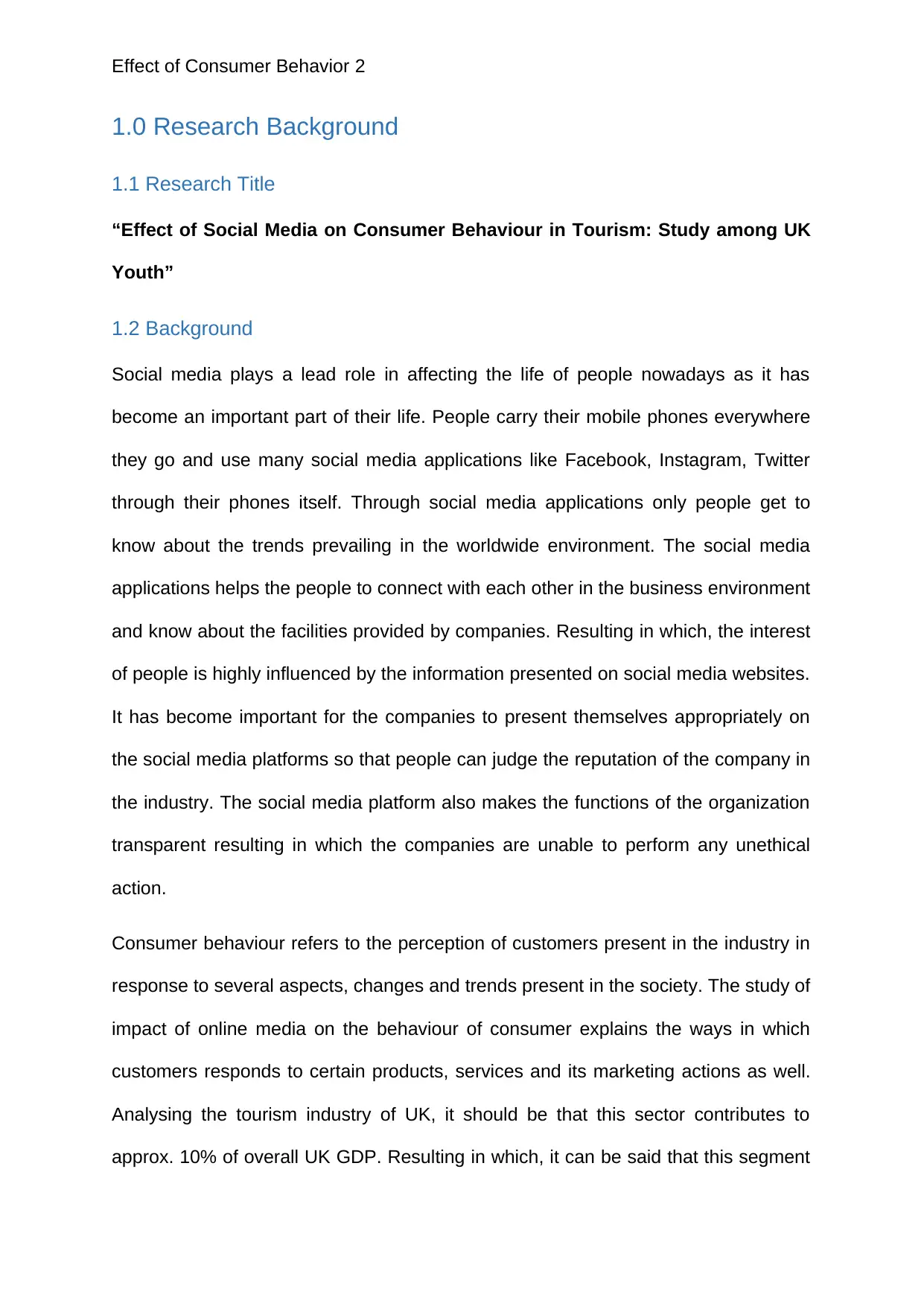
Effect of Consumer Behavior 2
1.0 Research Background
1.1 Research Title
“Effect of Social Media on Consumer Behaviour in Tourism: Study among UK
Youth”
1.2 Background
Social media plays a lead role in affecting the life of people nowadays as it has
become an important part of their life. People carry their mobile phones everywhere
they go and use many social media applications like Facebook, Instagram, Twitter
through their phones itself. Through social media applications only people get to
know about the trends prevailing in the worldwide environment. The social media
applications helps the people to connect with each other in the business environment
and know about the facilities provided by companies. Resulting in which, the interest
of people is highly influenced by the information presented on social media websites.
It has become important for the companies to present themselves appropriately on
the social media platforms so that people can judge the reputation of the company in
the industry. The social media platform also makes the functions of the organization
transparent resulting in which the companies are unable to perform any unethical
action.
Consumer behaviour refers to the perception of customers present in the industry in
response to several aspects, changes and trends present in the society. The study of
impact of online media on the behaviour of consumer explains the ways in which
customers responds to certain products, services and its marketing actions as well.
Analysing the tourism industry of UK, it should be that this sector contributes to
approx. 10% of overall UK GDP. Resulting in which, it can be said that this segment
1.0 Research Background
1.1 Research Title
“Effect of Social Media on Consumer Behaviour in Tourism: Study among UK
Youth”
1.2 Background
Social media plays a lead role in affecting the life of people nowadays as it has
become an important part of their life. People carry their mobile phones everywhere
they go and use many social media applications like Facebook, Instagram, Twitter
through their phones itself. Through social media applications only people get to
know about the trends prevailing in the worldwide environment. The social media
applications helps the people to connect with each other in the business environment
and know about the facilities provided by companies. Resulting in which, the interest
of people is highly influenced by the information presented on social media websites.
It has become important for the companies to present themselves appropriately on
the social media platforms so that people can judge the reputation of the company in
the industry. The social media platform also makes the functions of the organization
transparent resulting in which the companies are unable to perform any unethical
action.
Consumer behaviour refers to the perception of customers present in the industry in
response to several aspects, changes and trends present in the society. The study of
impact of online media on the behaviour of consumer explains the ways in which
customers responds to certain products, services and its marketing actions as well.
Analysing the tourism industry of UK, it should be that this sector contributes to
approx. 10% of overall UK GDP. Resulting in which, it can be said that this segment
⊘ This is a preview!⊘
Do you want full access?
Subscribe today to unlock all pages.

Trusted by 1+ million students worldwide
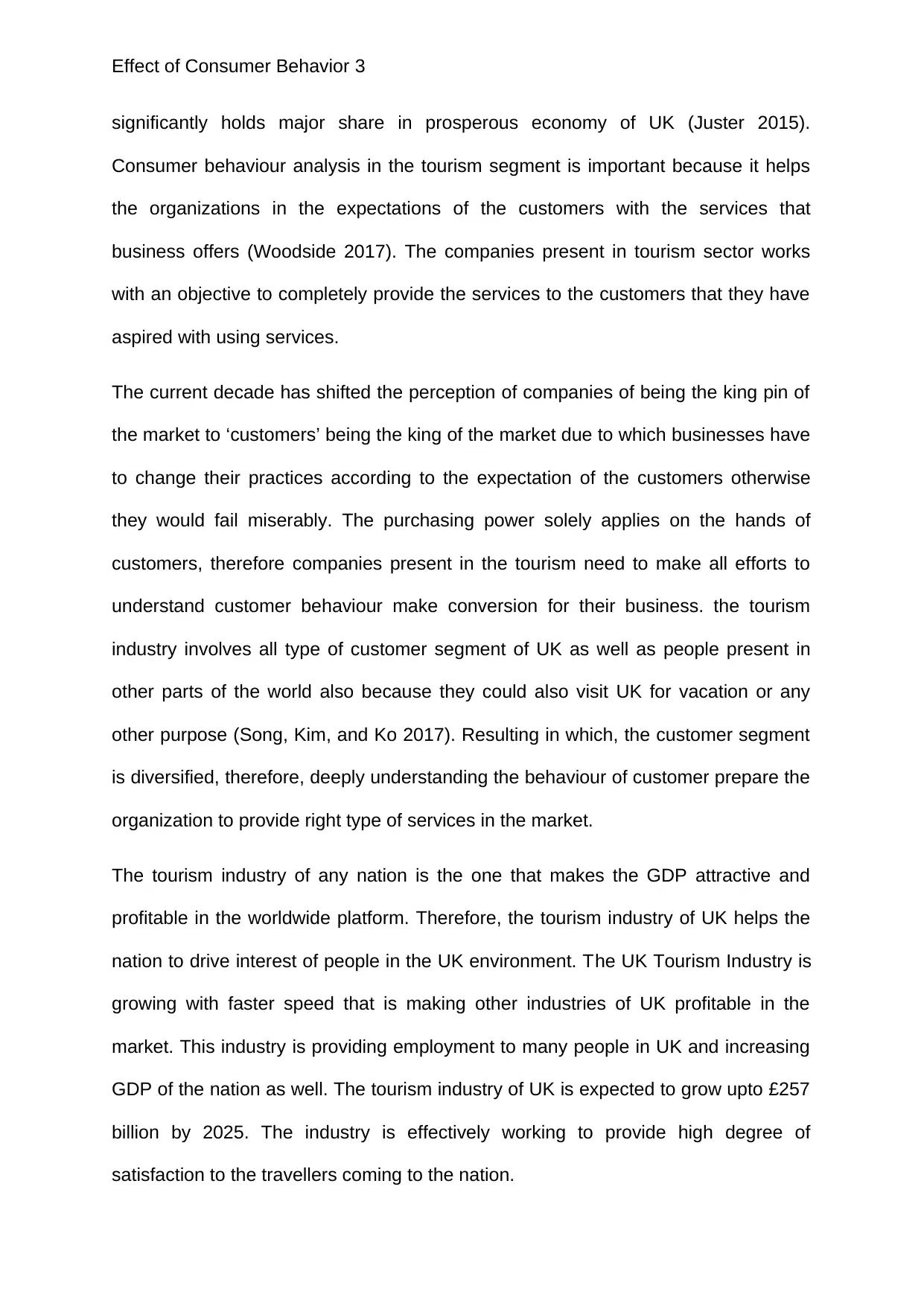
Effect of Consumer Behavior 3
significantly holds major share in prosperous economy of UK (Juster 2015).
Consumer behaviour analysis in the tourism segment is important because it helps
the organizations in the expectations of the customers with the services that
business offers (Woodside 2017). The companies present in tourism sector works
with an objective to completely provide the services to the customers that they have
aspired with using services.
The current decade has shifted the perception of companies of being the king pin of
the market to ‘customers’ being the king of the market due to which businesses have
to change their practices according to the expectation of the customers otherwise
they would fail miserably. The purchasing power solely applies on the hands of
customers, therefore companies present in the tourism need to make all efforts to
understand customer behaviour make conversion for their business. the tourism
industry involves all type of customer segment of UK as well as people present in
other parts of the world also because they could also visit UK for vacation or any
other purpose (Song, Kim, and Ko 2017). Resulting in which, the customer segment
is diversified, therefore, deeply understanding the behaviour of customer prepare the
organization to provide right type of services in the market.
The tourism industry of any nation is the one that makes the GDP attractive and
profitable in the worldwide platform. Therefore, the tourism industry of UK helps the
nation to drive interest of people in the UK environment. The UK Tourism Industry is
growing with faster speed that is making other industries of UK profitable in the
market. This industry is providing employment to many people in UK and increasing
GDP of the nation as well. The tourism industry of UK is expected to grow upto £257
billion by 2025. The industry is effectively working to provide high degree of
satisfaction to the travellers coming to the nation.
significantly holds major share in prosperous economy of UK (Juster 2015).
Consumer behaviour analysis in the tourism segment is important because it helps
the organizations in the expectations of the customers with the services that
business offers (Woodside 2017). The companies present in tourism sector works
with an objective to completely provide the services to the customers that they have
aspired with using services.
The current decade has shifted the perception of companies of being the king pin of
the market to ‘customers’ being the king of the market due to which businesses have
to change their practices according to the expectation of the customers otherwise
they would fail miserably. The purchasing power solely applies on the hands of
customers, therefore companies present in the tourism need to make all efforts to
understand customer behaviour make conversion for their business. the tourism
industry involves all type of customer segment of UK as well as people present in
other parts of the world also because they could also visit UK for vacation or any
other purpose (Song, Kim, and Ko 2017). Resulting in which, the customer segment
is diversified, therefore, deeply understanding the behaviour of customer prepare the
organization to provide right type of services in the market.
The tourism industry of any nation is the one that makes the GDP attractive and
profitable in the worldwide platform. Therefore, the tourism industry of UK helps the
nation to drive interest of people in the UK environment. The UK Tourism Industry is
growing with faster speed that is making other industries of UK profitable in the
market. This industry is providing employment to many people in UK and increasing
GDP of the nation as well. The tourism industry of UK is expected to grow upto £257
billion by 2025. The industry is effectively working to provide high degree of
satisfaction to the travellers coming to the nation.
Paraphrase This Document
Need a fresh take? Get an instant paraphrase of this document with our AI Paraphraser
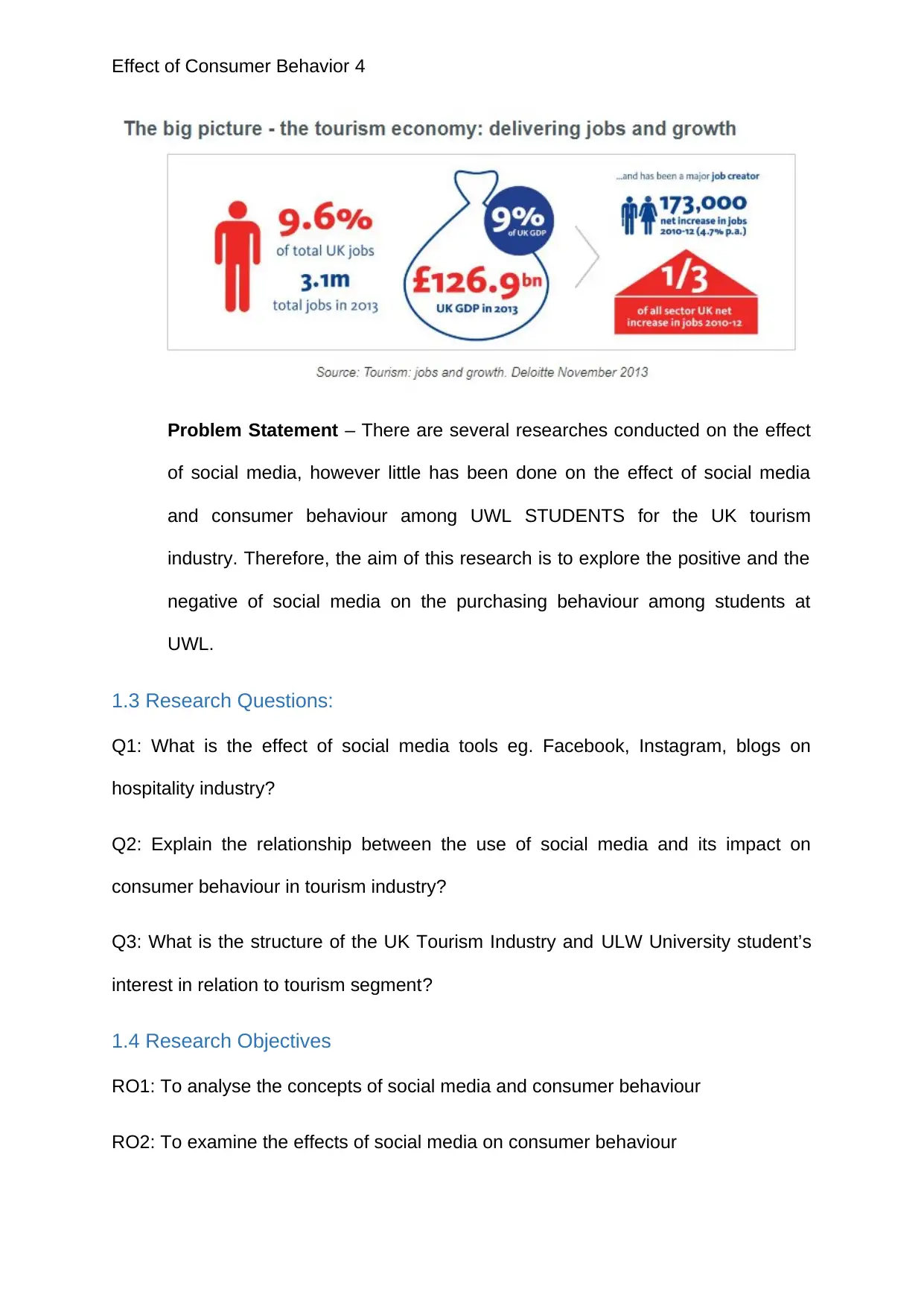
Effect of Consumer Behavior 4
Problem Statement – There are several researches conducted on the effect
of social media, however little has been done on the effect of social media
and consumer behaviour among UWL STUDENTS for the UK tourism
industry. Therefore, the aim of this research is to explore the positive and the
negative of social media on the purchasing behaviour among students at
UWL.
1.3 Research Questions:
Q1: What is the effect of social media tools eg. Facebook, Instagram, blogs on
hospitality industry?
Q2: Explain the relationship between the use of social media and its impact on
consumer behaviour in tourism industry?
Q3: What is the structure of the UK Tourism Industry and ULW University student’s
interest in relation to tourism segment?
1.4 Research Objectives
RO1: To analyse the concepts of social media and consumer behaviour
RO2: To examine the effects of social media on consumer behaviour
Problem Statement – There are several researches conducted on the effect
of social media, however little has been done on the effect of social media
and consumer behaviour among UWL STUDENTS for the UK tourism
industry. Therefore, the aim of this research is to explore the positive and the
negative of social media on the purchasing behaviour among students at
UWL.
1.3 Research Questions:
Q1: What is the effect of social media tools eg. Facebook, Instagram, blogs on
hospitality industry?
Q2: Explain the relationship between the use of social media and its impact on
consumer behaviour in tourism industry?
Q3: What is the structure of the UK Tourism Industry and ULW University student’s
interest in relation to tourism segment?
1.4 Research Objectives
RO1: To analyse the concepts of social media and consumer behaviour
RO2: To examine the effects of social media on consumer behaviour
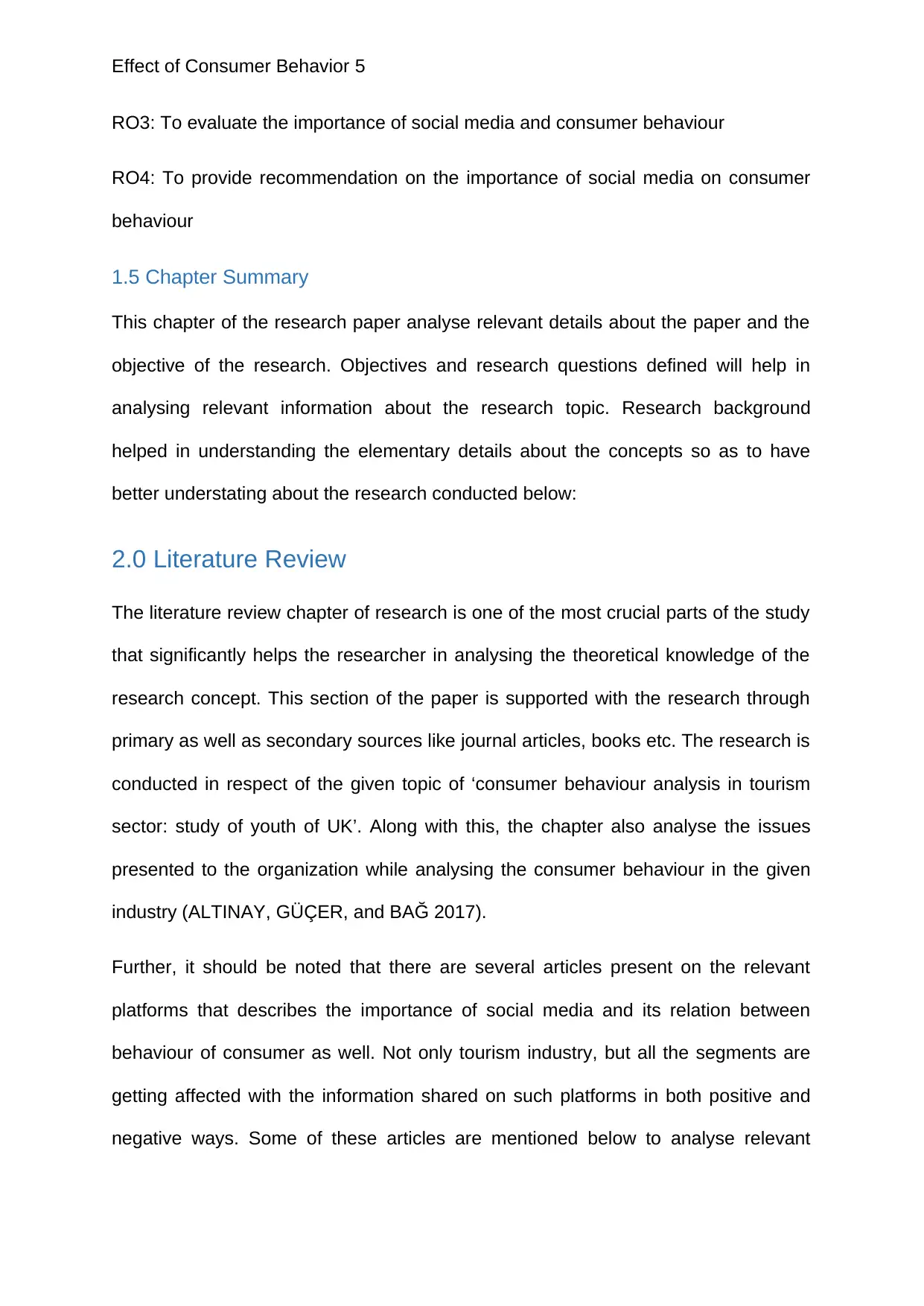
Effect of Consumer Behavior 5
RO3: To evaluate the importance of social media and consumer behaviour
RO4: To provide recommendation on the importance of social media on consumer
behaviour
1.5 Chapter Summary
This chapter of the research paper analyse relevant details about the paper and the
objective of the research. Objectives and research questions defined will help in
analysing relevant information about the research topic. Research background
helped in understanding the elementary details about the concepts so as to have
better understating about the research conducted below:
2.0 Literature Review
The literature review chapter of research is one of the most crucial parts of the study
that significantly helps the researcher in analysing the theoretical knowledge of the
research concept. This section of the paper is supported with the research through
primary as well as secondary sources like journal articles, books etc. The research is
conducted in respect of the given topic of ‘consumer behaviour analysis in tourism
sector: study of youth of UK’. Along with this, the chapter also analyse the issues
presented to the organization while analysing the consumer behaviour in the given
industry (ALTINAY, GÜÇER, and BAĞ 2017).
Further, it should be noted that there are several articles present on the relevant
platforms that describes the importance of social media and its relation between
behaviour of consumer as well. Not only tourism industry, but all the segments are
getting affected with the information shared on such platforms in both positive and
negative ways. Some of these articles are mentioned below to analyse relevant
RO3: To evaluate the importance of social media and consumer behaviour
RO4: To provide recommendation on the importance of social media on consumer
behaviour
1.5 Chapter Summary
This chapter of the research paper analyse relevant details about the paper and the
objective of the research. Objectives and research questions defined will help in
analysing relevant information about the research topic. Research background
helped in understanding the elementary details about the concepts so as to have
better understating about the research conducted below:
2.0 Literature Review
The literature review chapter of research is one of the most crucial parts of the study
that significantly helps the researcher in analysing the theoretical knowledge of the
research concept. This section of the paper is supported with the research through
primary as well as secondary sources like journal articles, books etc. The research is
conducted in respect of the given topic of ‘consumer behaviour analysis in tourism
sector: study of youth of UK’. Along with this, the chapter also analyse the issues
presented to the organization while analysing the consumer behaviour in the given
industry (ALTINAY, GÜÇER, and BAĞ 2017).
Further, it should be noted that there are several articles present on the relevant
platforms that describes the importance of social media and its relation between
behaviour of consumer as well. Not only tourism industry, but all the segments are
getting affected with the information shared on such platforms in both positive and
negative ways. Some of these articles are mentioned below to analyse relevant
⊘ This is a preview!⊘
Do you want full access?
Subscribe today to unlock all pages.

Trusted by 1+ million students worldwide
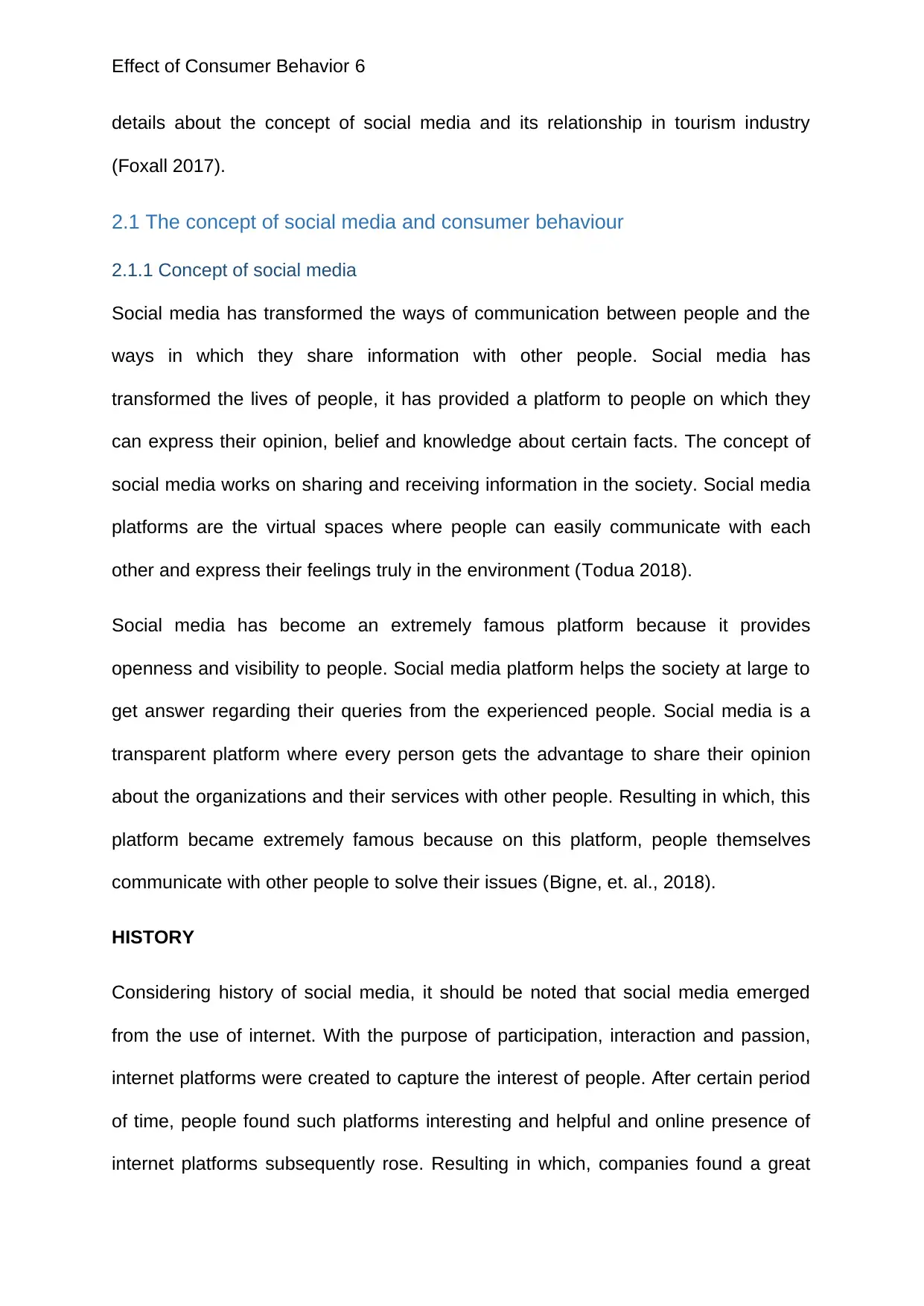
Effect of Consumer Behavior 6
details about the concept of social media and its relationship in tourism industry
(Foxall 2017).
2.1 The concept of social media and consumer behaviour
2.1.1 Concept of social media
Social media has transformed the ways of communication between people and the
ways in which they share information with other people. Social media has
transformed the lives of people, it has provided a platform to people on which they
can express their opinion, belief and knowledge about certain facts. The concept of
social media works on sharing and receiving information in the society. Social media
platforms are the virtual spaces where people can easily communicate with each
other and express their feelings truly in the environment (Todua 2018).
Social media has become an extremely famous platform because it provides
openness and visibility to people. Social media platform helps the society at large to
get answer regarding their queries from the experienced people. Social media is a
transparent platform where every person gets the advantage to share their opinion
about the organizations and their services with other people. Resulting in which, this
platform became extremely famous because on this platform, people themselves
communicate with other people to solve their issues (Bigne, et. al., 2018).
HISTORY
Considering history of social media, it should be noted that social media emerged
from the use of internet. With the purpose of participation, interaction and passion,
internet platforms were created to capture the interest of people. After certain period
of time, people found such platforms interesting and helpful and online presence of
internet platforms subsequently rose. Resulting in which, companies found a great
details about the concept of social media and its relationship in tourism industry
(Foxall 2017).
2.1 The concept of social media and consumer behaviour
2.1.1 Concept of social media
Social media has transformed the ways of communication between people and the
ways in which they share information with other people. Social media has
transformed the lives of people, it has provided a platform to people on which they
can express their opinion, belief and knowledge about certain facts. The concept of
social media works on sharing and receiving information in the society. Social media
platforms are the virtual spaces where people can easily communicate with each
other and express their feelings truly in the environment (Todua 2018).
Social media has become an extremely famous platform because it provides
openness and visibility to people. Social media platform helps the society at large to
get answer regarding their queries from the experienced people. Social media is a
transparent platform where every person gets the advantage to share their opinion
about the organizations and their services with other people. Resulting in which, this
platform became extremely famous because on this platform, people themselves
communicate with other people to solve their issues (Bigne, et. al., 2018).
HISTORY
Considering history of social media, it should be noted that social media emerged
from the use of internet. With the purpose of participation, interaction and passion,
internet platforms were created to capture the interest of people. After certain period
of time, people found such platforms interesting and helpful and online presence of
internet platforms subsequently rose. Resulting in which, companies found a great
Paraphrase This Document
Need a fresh take? Get an instant paraphrase of this document with our AI Paraphraser
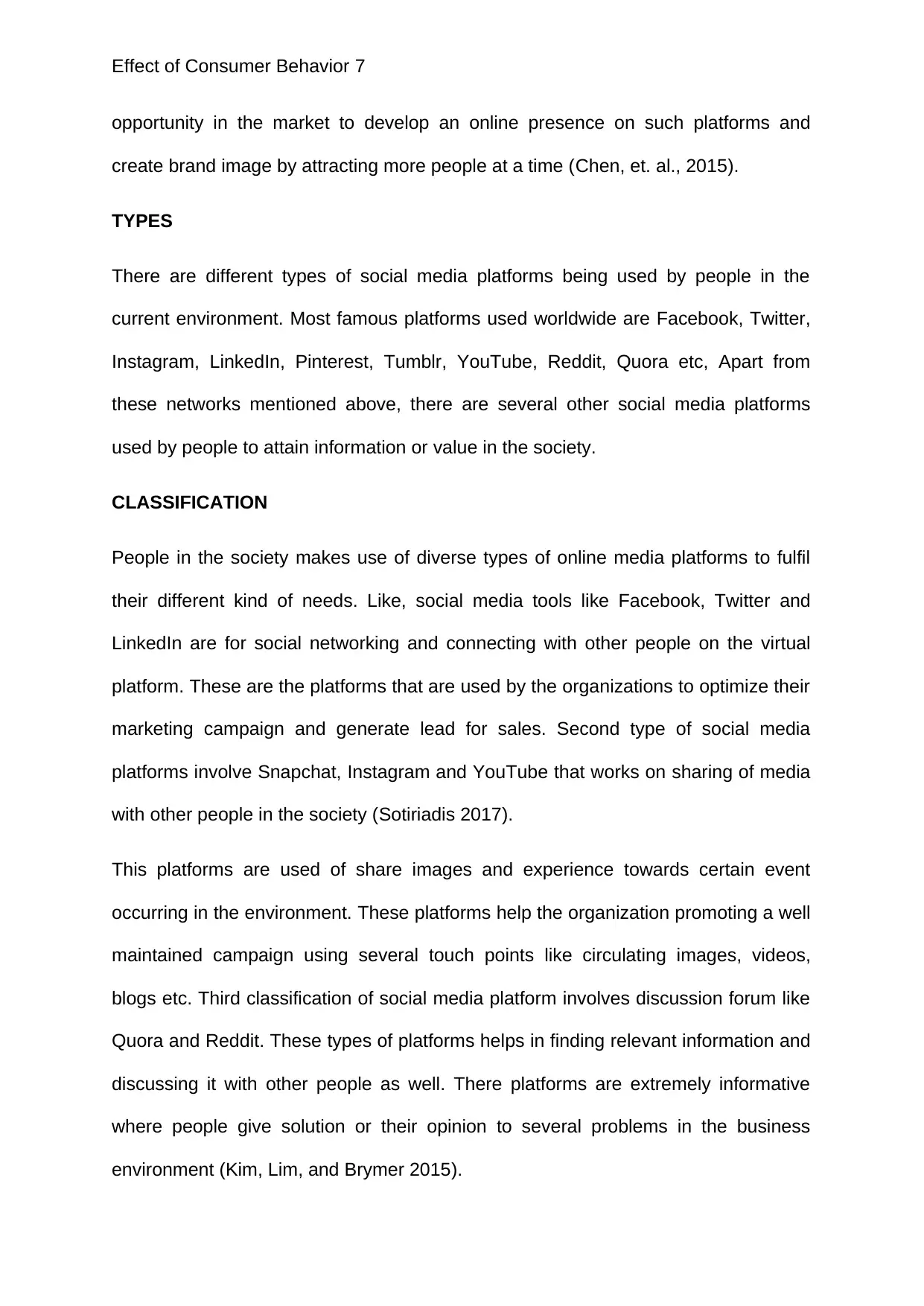
Effect of Consumer Behavior 7
opportunity in the market to develop an online presence on such platforms and
create brand image by attracting more people at a time (Chen, et. al., 2015).
TYPES
There are different types of social media platforms being used by people in the
current environment. Most famous platforms used worldwide are Facebook, Twitter,
Instagram, LinkedIn, Pinterest, Tumblr, YouTube, Reddit, Quora etc, Apart from
these networks mentioned above, there are several other social media platforms
used by people to attain information or value in the society.
CLASSIFICATION
People in the society makes use of diverse types of online media platforms to fulfil
their different kind of needs. Like, social media tools like Facebook, Twitter and
LinkedIn are for social networking and connecting with other people on the virtual
platform. These are the platforms that are used by the organizations to optimize their
marketing campaign and generate lead for sales. Second type of social media
platforms involve Snapchat, Instagram and YouTube that works on sharing of media
with other people in the society (Sotiriadis 2017).
This platforms are used of share images and experience towards certain event
occurring in the environment. These platforms help the organization promoting a well
maintained campaign using several touch points like circulating images, videos,
blogs etc. Third classification of social media platform involves discussion forum like
Quora and Reddit. These types of platforms helps in finding relevant information and
discussing it with other people as well. There platforms are extremely informative
where people give solution or their opinion to several problems in the business
environment (Kim, Lim, and Brymer 2015).
opportunity in the market to develop an online presence on such platforms and
create brand image by attracting more people at a time (Chen, et. al., 2015).
TYPES
There are different types of social media platforms being used by people in the
current environment. Most famous platforms used worldwide are Facebook, Twitter,
Instagram, LinkedIn, Pinterest, Tumblr, YouTube, Reddit, Quora etc, Apart from
these networks mentioned above, there are several other social media platforms
used by people to attain information or value in the society.
CLASSIFICATION
People in the society makes use of diverse types of online media platforms to fulfil
their different kind of needs. Like, social media tools like Facebook, Twitter and
LinkedIn are for social networking and connecting with other people on the virtual
platform. These are the platforms that are used by the organizations to optimize their
marketing campaign and generate lead for sales. Second type of social media
platforms involve Snapchat, Instagram and YouTube that works on sharing of media
with other people in the society (Sotiriadis 2017).
This platforms are used of share images and experience towards certain event
occurring in the environment. These platforms help the organization promoting a well
maintained campaign using several touch points like circulating images, videos,
blogs etc. Third classification of social media platform involves discussion forum like
Quora and Reddit. These types of platforms helps in finding relevant information and
discussing it with other people as well. There platforms are extremely informative
where people give solution or their opinion to several problems in the business
environment (Kim, Lim, and Brymer 2015).
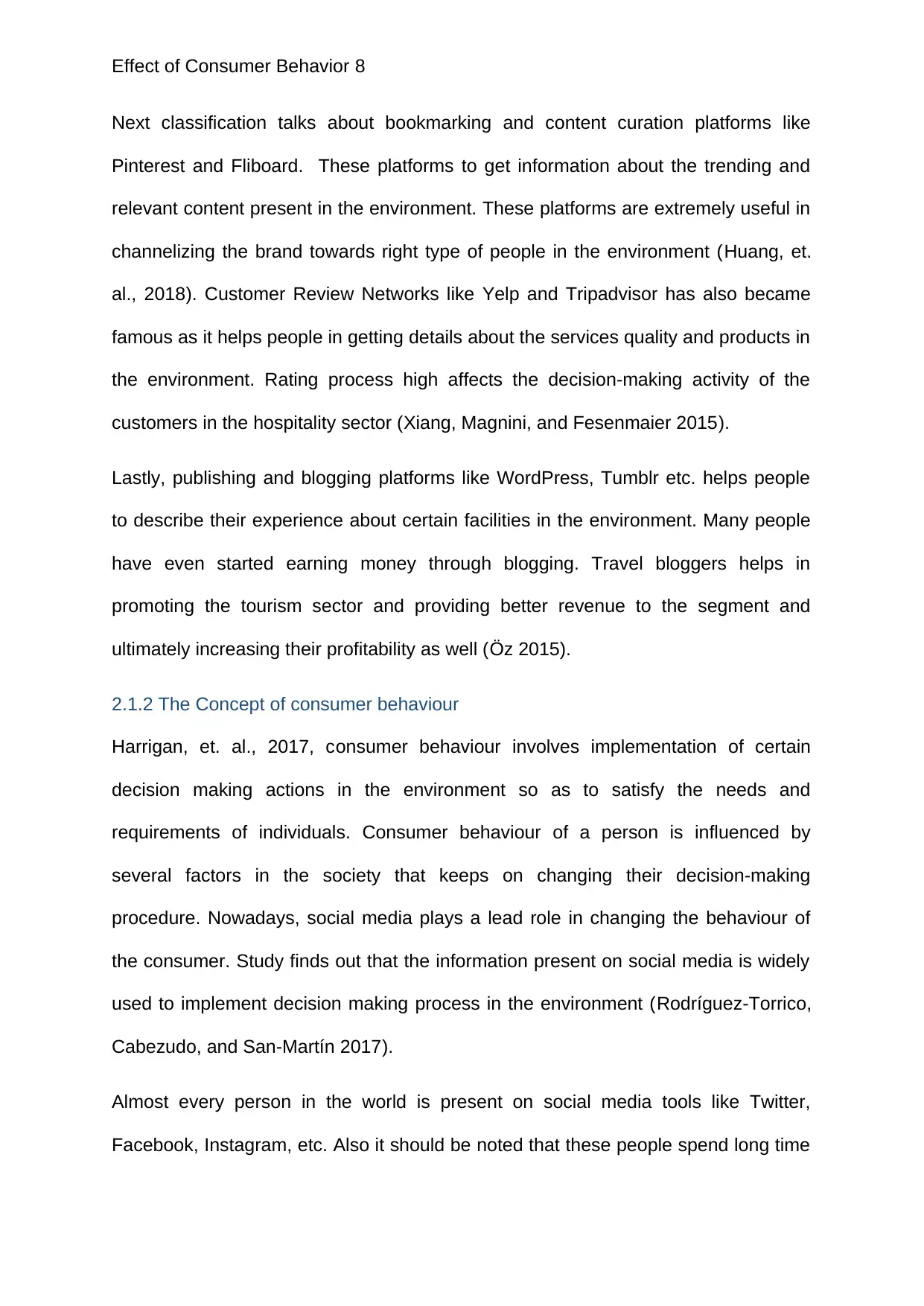
Effect of Consumer Behavior 8
Next classification talks about bookmarking and content curation platforms like
Pinterest and Fliboard. These platforms to get information about the trending and
relevant content present in the environment. These platforms are extremely useful in
channelizing the brand towards right type of people in the environment (Huang, et.
al., 2018). Customer Review Networks like Yelp and Tripadvisor has also became
famous as it helps people in getting details about the services quality and products in
the environment. Rating process high affects the decision-making activity of the
customers in the hospitality sector (Xiang, Magnini, and Fesenmaier 2015).
Lastly, publishing and blogging platforms like WordPress, Tumblr etc. helps people
to describe their experience about certain facilities in the environment. Many people
have even started earning money through blogging. Travel bloggers helps in
promoting the tourism sector and providing better revenue to the segment and
ultimately increasing their profitability as well (Öz 2015).
2.1.2 The Concept of consumer behaviour
Harrigan, et. al., 2017, consumer behaviour involves implementation of certain
decision making actions in the environment so as to satisfy the needs and
requirements of individuals. Consumer behaviour of a person is influenced by
several factors in the society that keeps on changing their decision-making
procedure. Nowadays, social media plays a lead role in changing the behaviour of
the consumer. Study finds out that the information present on social media is widely
used to implement decision making process in the environment (Rodríguez-Torrico,
Cabezudo, and San-Martín 2017).
Almost every person in the world is present on social media tools like Twitter,
Facebook, Instagram, etc. Also it should be noted that these people spend long time
Next classification talks about bookmarking and content curation platforms like
Pinterest and Fliboard. These platforms to get information about the trending and
relevant content present in the environment. These platforms are extremely useful in
channelizing the brand towards right type of people in the environment (Huang, et.
al., 2018). Customer Review Networks like Yelp and Tripadvisor has also became
famous as it helps people in getting details about the services quality and products in
the environment. Rating process high affects the decision-making activity of the
customers in the hospitality sector (Xiang, Magnini, and Fesenmaier 2015).
Lastly, publishing and blogging platforms like WordPress, Tumblr etc. helps people
to describe their experience about certain facilities in the environment. Many people
have even started earning money through blogging. Travel bloggers helps in
promoting the tourism sector and providing better revenue to the segment and
ultimately increasing their profitability as well (Öz 2015).
2.1.2 The Concept of consumer behaviour
Harrigan, et. al., 2017, consumer behaviour involves implementation of certain
decision making actions in the environment so as to satisfy the needs and
requirements of individuals. Consumer behaviour of a person is influenced by
several factors in the society that keeps on changing their decision-making
procedure. Nowadays, social media plays a lead role in changing the behaviour of
the consumer. Study finds out that the information present on social media is widely
used to implement decision making process in the environment (Rodríguez-Torrico,
Cabezudo, and San-Martín 2017).
Almost every person in the world is present on social media tools like Twitter,
Facebook, Instagram, etc. Also it should be noted that these people spend long time
⊘ This is a preview!⊘
Do you want full access?
Subscribe today to unlock all pages.

Trusted by 1+ million students worldwide
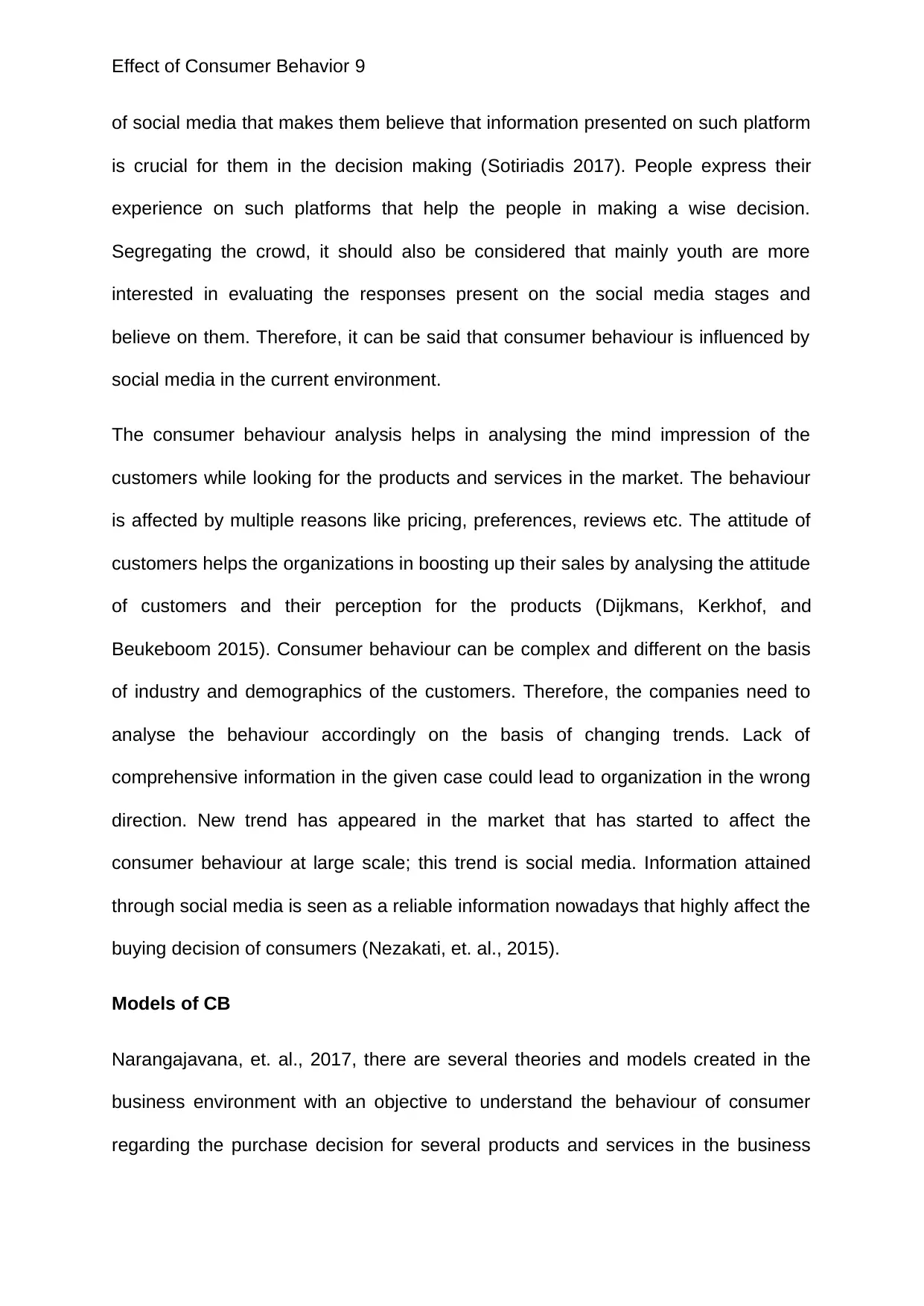
Effect of Consumer Behavior 9
of social media that makes them believe that information presented on such platform
is crucial for them in the decision making (Sotiriadis 2017). People express their
experience on such platforms that help the people in making a wise decision.
Segregating the crowd, it should also be considered that mainly youth are more
interested in evaluating the responses present on the social media stages and
believe on them. Therefore, it can be said that consumer behaviour is influenced by
social media in the current environment.
The consumer behaviour analysis helps in analysing the mind impression of the
customers while looking for the products and services in the market. The behaviour
is affected by multiple reasons like pricing, preferences, reviews etc. The attitude of
customers helps the organizations in boosting up their sales by analysing the attitude
of customers and their perception for the products (Dijkmans, Kerkhof, and
Beukeboom 2015). Consumer behaviour can be complex and different on the basis
of industry and demographics of the customers. Therefore, the companies need to
analyse the behaviour accordingly on the basis of changing trends. Lack of
comprehensive information in the given case could lead to organization in the wrong
direction. New trend has appeared in the market that has started to affect the
consumer behaviour at large scale; this trend is social media. Information attained
through social media is seen as a reliable information nowadays that highly affect the
buying decision of consumers (Nezakati, et. al., 2015).
Models of CB
Narangajavana, et. al., 2017, there are several theories and models created in the
business environment with an objective to understand the behaviour of consumer
regarding the purchase decision for several products and services in the business
of social media that makes them believe that information presented on such platform
is crucial for them in the decision making (Sotiriadis 2017). People express their
experience on such platforms that help the people in making a wise decision.
Segregating the crowd, it should also be considered that mainly youth are more
interested in evaluating the responses present on the social media stages and
believe on them. Therefore, it can be said that consumer behaviour is influenced by
social media in the current environment.
The consumer behaviour analysis helps in analysing the mind impression of the
customers while looking for the products and services in the market. The behaviour
is affected by multiple reasons like pricing, preferences, reviews etc. The attitude of
customers helps the organizations in boosting up their sales by analysing the attitude
of customers and their perception for the products (Dijkmans, Kerkhof, and
Beukeboom 2015). Consumer behaviour can be complex and different on the basis
of industry and demographics of the customers. Therefore, the companies need to
analyse the behaviour accordingly on the basis of changing trends. Lack of
comprehensive information in the given case could lead to organization in the wrong
direction. New trend has appeared in the market that has started to affect the
consumer behaviour at large scale; this trend is social media. Information attained
through social media is seen as a reliable information nowadays that highly affect the
buying decision of consumers (Nezakati, et. al., 2015).
Models of CB
Narangajavana, et. al., 2017, there are several theories and models created in the
business environment with an objective to understand the behaviour of consumer
regarding the purchase decision for several products and services in the business
Paraphrase This Document
Need a fresh take? Get an instant paraphrase of this document with our AI Paraphraser
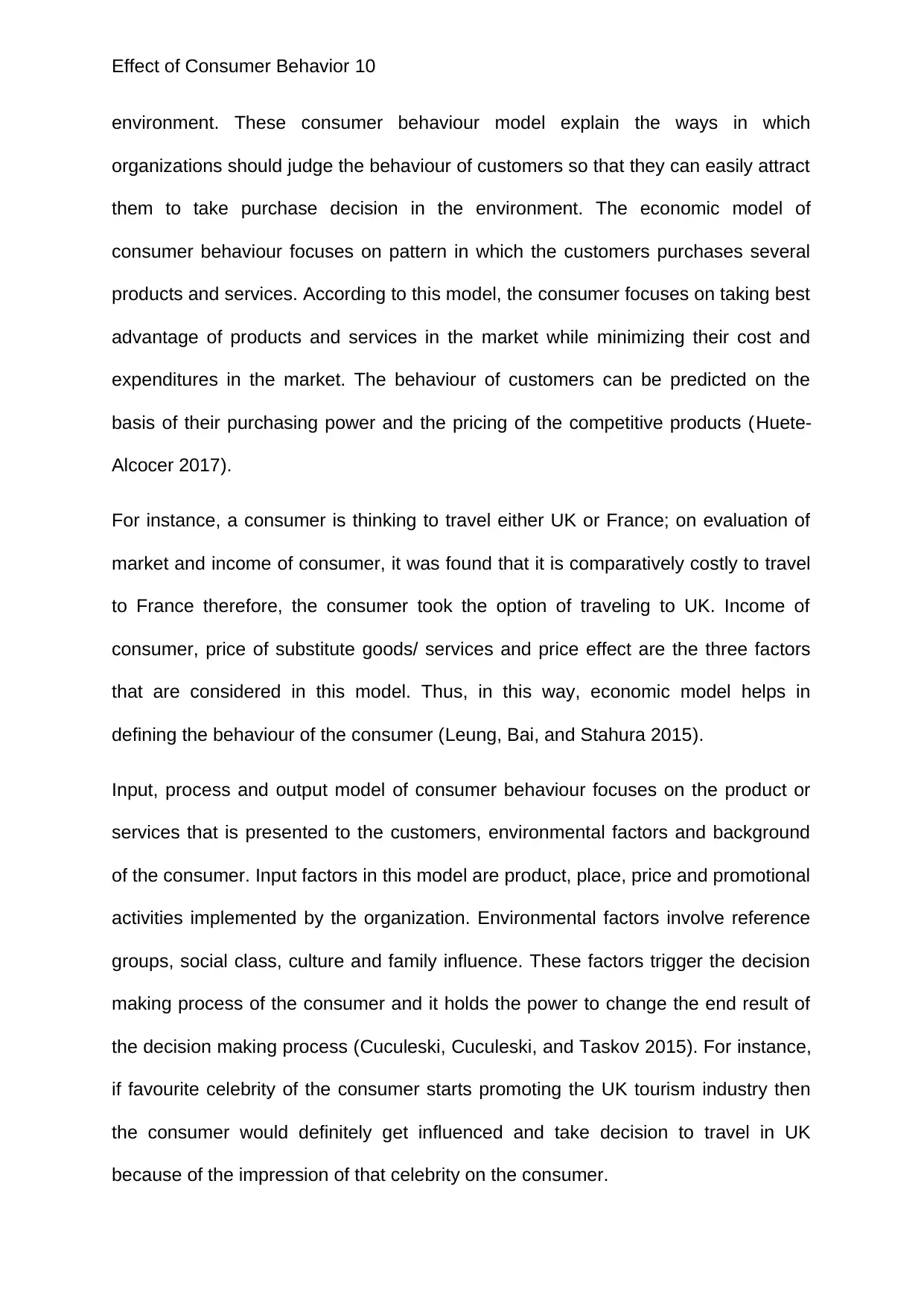
Effect of Consumer Behavior 10
environment. These consumer behaviour model explain the ways in which
organizations should judge the behaviour of customers so that they can easily attract
them to take purchase decision in the environment. The economic model of
consumer behaviour focuses on pattern in which the customers purchases several
products and services. According to this model, the consumer focuses on taking best
advantage of products and services in the market while minimizing their cost and
expenditures in the market. The behaviour of customers can be predicted on the
basis of their purchasing power and the pricing of the competitive products (Huete-
Alcocer 2017).
For instance, a consumer is thinking to travel either UK or France; on evaluation of
market and income of consumer, it was found that it is comparatively costly to travel
to France therefore, the consumer took the option of traveling to UK. Income of
consumer, price of substitute goods/ services and price effect are the three factors
that are considered in this model. Thus, in this way, economic model helps in
defining the behaviour of the consumer (Leung, Bai, and Stahura 2015).
Input, process and output model of consumer behaviour focuses on the product or
services that is presented to the customers, environmental factors and background
of the consumer. Input factors in this model are product, place, price and promotional
activities implemented by the organization. Environmental factors involve reference
groups, social class, culture and family influence. These factors trigger the decision
making process of the consumer and it holds the power to change the end result of
the decision making process (Cuculeski, Cuculeski, and Taskov 2015). For instance,
if favourite celebrity of the consumer starts promoting the UK tourism industry then
the consumer would definitely get influenced and take decision to travel in UK
because of the impression of that celebrity on the consumer.
environment. These consumer behaviour model explain the ways in which
organizations should judge the behaviour of customers so that they can easily attract
them to take purchase decision in the environment. The economic model of
consumer behaviour focuses on pattern in which the customers purchases several
products and services. According to this model, the consumer focuses on taking best
advantage of products and services in the market while minimizing their cost and
expenditures in the market. The behaviour of customers can be predicted on the
basis of their purchasing power and the pricing of the competitive products (Huete-
Alcocer 2017).
For instance, a consumer is thinking to travel either UK or France; on evaluation of
market and income of consumer, it was found that it is comparatively costly to travel
to France therefore, the consumer took the option of traveling to UK. Income of
consumer, price of substitute goods/ services and price effect are the three factors
that are considered in this model. Thus, in this way, economic model helps in
defining the behaviour of the consumer (Leung, Bai, and Stahura 2015).
Input, process and output model of consumer behaviour focuses on the product or
services that is presented to the customers, environmental factors and background
of the consumer. Input factors in this model are product, place, price and promotional
activities implemented by the organization. Environmental factors involve reference
groups, social class, culture and family influence. These factors trigger the decision
making process of the consumer and it holds the power to change the end result of
the decision making process (Cuculeski, Cuculeski, and Taskov 2015). For instance,
if favourite celebrity of the consumer starts promoting the UK tourism industry then
the consumer would definitely get influenced and take decision to travel in UK
because of the impression of that celebrity on the consumer.
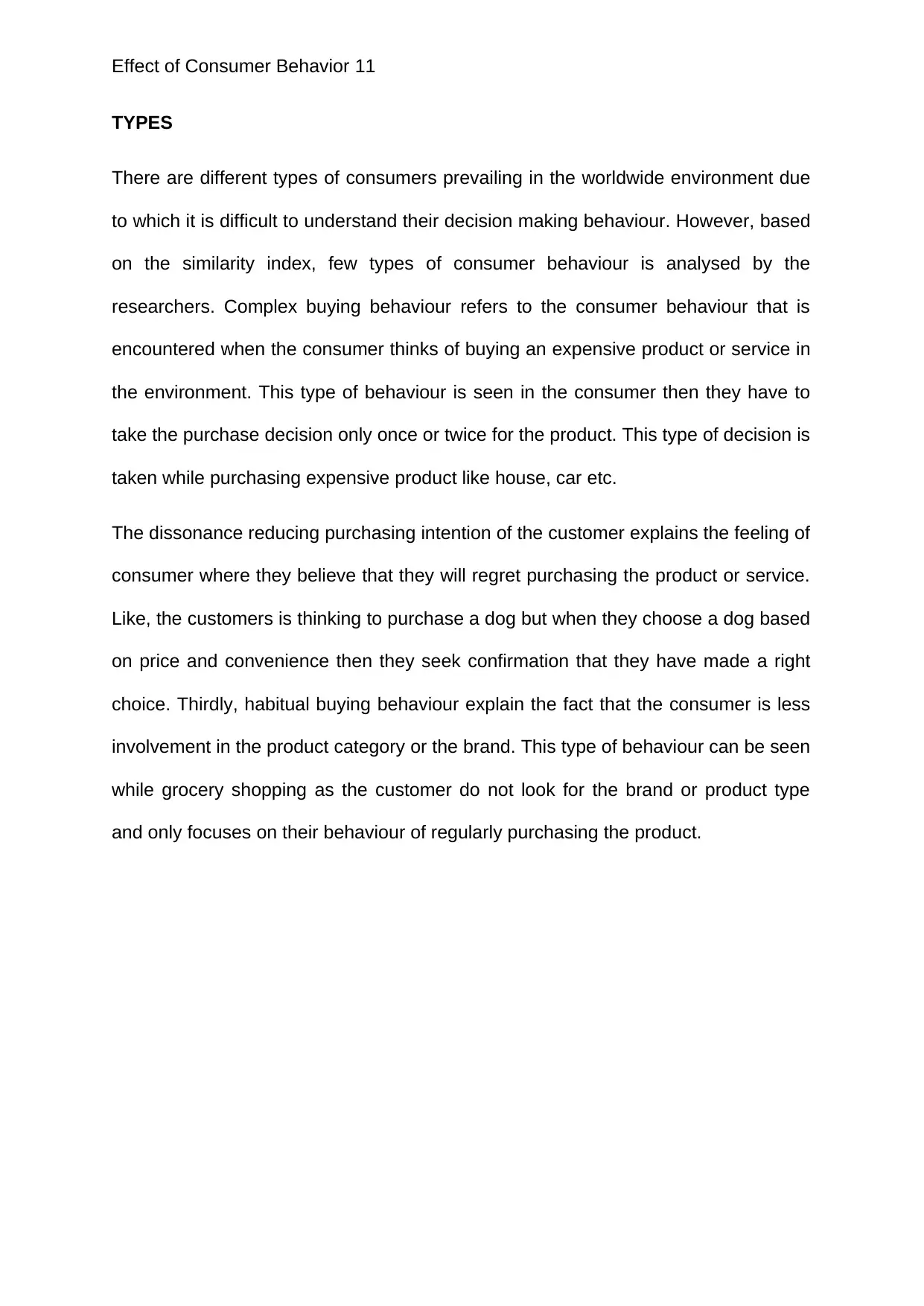
Effect of Consumer Behavior 11
TYPES
There are different types of consumers prevailing in the worldwide environment due
to which it is difficult to understand their decision making behaviour. However, based
on the similarity index, few types of consumer behaviour is analysed by the
researchers. Complex buying behaviour refers to the consumer behaviour that is
encountered when the consumer thinks of buying an expensive product or service in
the environment. This type of behaviour is seen in the consumer then they have to
take the purchase decision only once or twice for the product. This type of decision is
taken while purchasing expensive product like house, car etc.
The dissonance reducing purchasing intention of the customer explains the feeling of
consumer where they believe that they will regret purchasing the product or service.
Like, the customers is thinking to purchase a dog but when they choose a dog based
on price and convenience then they seek confirmation that they have made a right
choice. Thirdly, habitual buying behaviour explain the fact that the consumer is less
involvement in the product category or the brand. This type of behaviour can be seen
while grocery shopping as the customer do not look for the brand or product type
and only focuses on their behaviour of regularly purchasing the product.
TYPES
There are different types of consumers prevailing in the worldwide environment due
to which it is difficult to understand their decision making behaviour. However, based
on the similarity index, few types of consumer behaviour is analysed by the
researchers. Complex buying behaviour refers to the consumer behaviour that is
encountered when the consumer thinks of buying an expensive product or service in
the environment. This type of behaviour is seen in the consumer then they have to
take the purchase decision only once or twice for the product. This type of decision is
taken while purchasing expensive product like house, car etc.
The dissonance reducing purchasing intention of the customer explains the feeling of
consumer where they believe that they will regret purchasing the product or service.
Like, the customers is thinking to purchase a dog but when they choose a dog based
on price and convenience then they seek confirmation that they have made a right
choice. Thirdly, habitual buying behaviour explain the fact that the consumer is less
involvement in the product category or the brand. This type of behaviour can be seen
while grocery shopping as the customer do not look for the brand or product type
and only focuses on their behaviour of regularly purchasing the product.
⊘ This is a preview!⊘
Do you want full access?
Subscribe today to unlock all pages.

Trusted by 1+ million students worldwide
1 out of 39
Related Documents
Your All-in-One AI-Powered Toolkit for Academic Success.
+13062052269
info@desklib.com
Available 24*7 on WhatsApp / Email
![[object Object]](/_next/static/media/star-bottom.7253800d.svg)
Unlock your academic potential
Copyright © 2020–2025 A2Z Services. All Rights Reserved. Developed and managed by ZUCOL.





